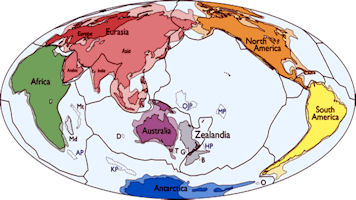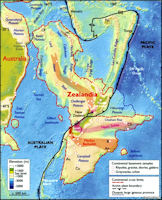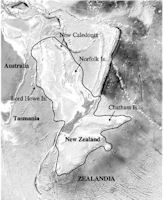New Zealand Geography - Zealandia
New Zealand is just the tip of a submerged continent in the southwest Pacific Ocean, that should be considered an eighth continent. They’re calling it Zealandia in a nod to the largest part of the continent that is above water, New Zealand. Zealandia was first named in 1995 by American scientist Bruce Luyendyk. Zealandia may have broken off from the supercontinent Gondwana between 60 and 85 million years ago.
New Zealand is a group of islands (270,534 km2) isolated by more than 1500 km of ocean from any other significant land area, but is continental in stratigraphic composition. According to a paper on Zealandia published in the Geological Society of America, researchers say the continent is about two-thirds the size of Australia, measuring some five million square kilometers. Only six percent, however, is above water, the majority of which is New Zealand, New Caledonia and some smaller islands.
Though frequently referred to as a Gondwanan element, the relevance of this term has been increasingly questioned. The term ‘Gondwanan’ can be misleading when applied to indicate historical process rather than simply distribution pattern. Traditionally, New Zealand has been associated with the continent of Australia. While continents are normally thought of as needing to be above water, researchers say the new continent does meet other requirements to the title, including elevation over the surrounding area, distinct geology, a well-defined area and crust thicker than the ocean floor.
The Tasman Ocean that today separates New Zealand from the nearest continent (Australia) began forming ca 83 Ma. A section of continental crust rotated away from the eastern Australian section of Gondwanaland and this fragment is referred to as Zealandia.
In geological terms, ‘continental’ means being composed of continental rather than oceanic crust, but for continental crust to be emergent as land, it has to be thick enough to stand above sea level. Zealandia is much larger than modern New Zealand, about the size of India, and includes the Campbell Plateau, Challenger Plateau, Lord Howe Rise, Norfolk Ridge, Chatham Rise and New Caledonia. Over about 60 million years, Zealandia was stretched and thinned, effectively losing buoyancy, and sinking some 2–3000m.
Today, approximately 93 per cent of Zealandia is beneath the sea, and in the Oligocene the New Zealand sector may have also been entirely submerged. New Zealand exists above water today owing to a plate boundary collision. It has been vigorous and sustained since its abrupt initiation in latest Oligocene time. This activity is prominently expressed along the alpine fault, where tectonic activity has generated 480 km of lateral motion and, since the Pliocene, some 20 km of uplift resulting in the formation of the Southern Alps.
According to the lead author of a paper on Zealandia published in February 2017 in the Geological Society of America, Nick Mortimer, it will be hard to get Zealandia classified as a continent because it’s under water. “If we could pull the plug on the oceans, it would be clear to everybody that we have mountain chains and a big, high-standing continent,” he told TVNZ. “What we hope is that Zealandia will appear on world maps, in schools, everywhere ...I think the revelation of a new continent is pretty exciting.” There may be eight continents after all.
It has specifically and popularly been described as "Moa's ark". Julia Goldberg et al wrote in 2008 that New Zealand biogeography has been dominated by the knowledge that its geophysical history is continental in nature. The continental crust (Zealandia) from which New Zealand is formed broke from Gondwanaland ca 80 Ma, and there has existed a pervading view that the native biota is primarily a product of this long isolation. However, molecular studies of terrestrial animals and plants in New Zealand indicate that many taxa arrived since isolation of the land, and that diversification in most groups is relatively recent. This is consistent with evidence for species turnover from the fossil record, taxonomic affinity, tectonic evidence and observations of biological composition and interactions. Extinction, colonization and speciation have yielded a biota in New Zealand which is, in most respects, more like that of an oceanic archipelago than a continent.
|
NEWSLETTER
|
| Join the GlobalSecurity.org mailing list |
|
|
|




